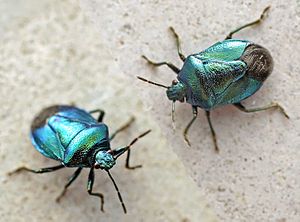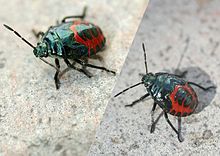Zicrona caerulea
| Zicrona caerulea | ||||||||||||
|---|---|---|---|---|---|---|---|---|---|---|---|---|

Zicrona caerulea |
||||||||||||
| Systematics | ||||||||||||
|
||||||||||||
| Scientific name | ||||||||||||
| Zicrona caerulea | ||||||||||||
| ( Linnaeus , 1758) |
Zicrona caerulea , also known as Blue Green Shield Bug known is a Wanzenart from the family of stink bugs (Pentatomidae).
features
The small blue-green metallic colored bugs are 5-8 mm long, for North America 7 to 9 millimeters are given. Depending on the incidence of light, they can also shimmer purple. The membrane is dark. In contrast to similar types of bugs, the femora of the front legs have no thorns. The relatively thick proboscis reaches the rear hips, its second segment is the longest, but shorter than the third and fourth combined. The side corners of the pronotum are not protruding or elongated. The first abdominal segment does not have a thorn on the ventral side. The seventh abdomen git is extended to the rear, it protrudes beyond the male's reproductive organs. The nymphs have a red abdomen with a black pattern.
Occurrence and habitat
Zicrona caerulea is represented in large parts of Eurasia as well as in North America. They occur all over Europe, North Africa, the Middle East, Central and East Asia, east to Japan and Korea, south to Java. In North America they live in the USA and Canada, south to Texas. The bug species is often found on the edges of forests, in heather and moor areas. The bugs usually stay in the lower vegetation layer.
Way of life
The bugs feed on insects both as plants and predatory. Their prey includes leaf beetles and butterfly caterpillars, especially flea beetles of the genus Altica and their larvae. The theory was put forward that the blue-metallic color of the bug species evolved as a mimicry , since the blue-metallic beetles are rarely attacked by birds because of their jumping ability. The flyable bugs rarely fly.
Zicrona caerulea forms one generation per year. The bug species overwinters as an imago. There are five stages of nymphs. The newly developed adults can be observed from July.
Taxonomy
The species was first described by Linnaeus as Cimex caeruleus . It is a type species of the genus Zicrona Amyot & Serville 1843 by subsequent definition by Kirkaldy 1903. Synonyms are Pentatoma caeruleum Tigny 1802, Asopus caeruleus Burmeister 1835, Pentatoma concinna Westwood 1837, Pentatoma violacea Westwood 1837, Stiretrus caeruleus Blanchard 1840, Amyoticrona illustris & Servis 1840 , Zicrona cuprea Dallas 1851. The genus Zicrona includes two other species, Zicrona hisarensis Chopra & Sucheta 1984 from India and Zicrona americana Thomas, 1992 from the southern USA and Mexico. Numerous other species are now assigned to other genera. In Europe it is the only species of the genus, it is unmistakable here.
etymology
The species name caerulea is derived from Latin: caerulea = "blue", "bluish", "sky blue" or "dark blue". The name refers to the typical coloring of the bedbugs.
Individual evidence
- ↑ a b c Frieder Sauer: Sauer's nature guide recognized bugs and cicadas from color photos . Fauna, Keltern 1996, ISBN 3-923010-12-5 , p. 68 .
- ↑ a b c d e f g h Zicrona caerulea. British Bugs, accessed December 20, 2016 .
- ↑ SM Paiero, SA Marshall, JE McPherson, M.-S. Ma (2013): Stink bugs (Pentatomidae) and parent bugs (Acanthosomatidae) of Ontario and adjacent areas: A key to species and a review of the fauna. Canadian Journal of Arthropod Identification No. 24. doi : 10.3752 / cjai.2013.24
- ↑ a b c Donald B. Thomas (1994): Taxonomic synopsis of the Old World asopine genera (Heteroptera: Pentatomidae). Insecta Mundi 296.
- ↑ Zicrona caerulea. Nature in NRW, accessed on December 20, 2016 .
- ↑ Zicrona caerulea. Bug Guide, accessed December 20, 2016 .
- ^ David G. Furth (1980): Altica of Israel (Chrysomelidae: Alticinae). Israel Journal of Entomology 14: 55-66.
- ^ Donald B. Thomas (1992): Taxonomic synopsis of the asopine Pentatomidae (Heteroptera) of the Western Hemisphere. Entomological Society of America, Lanham, Maryland 1992.
literature
- Frieder Sauer: Sauer's nature guide recognized bugs and cicadas from color photos . Fauna, Keltern 1996, ISBN 3-923010-12-5 .
Web links
- Zicrona caerulea at Fauna Europaea. Retrieved December 20, 2016
